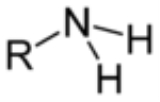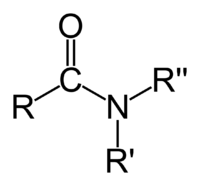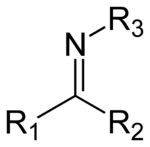
Carbon-nitrogen bond
Encyclopedia
A carbon–nitrogen bond is a covalent bond
between carbon
and nitrogen
and is one of the most abundant bonds in organic chemistry
and biochemistry
.
Nitrogen has five valence electron
s and in simple amines it is trivalent
, with the two remaining electrons forming a lone pair
. Through that pair, nitrogen can form an additional bond to hydrogen
making it tetravalent and with a positive charge in ammonium salts. Many nitrogen compounds can thus be potentially basic
but its degree depends on the configuration: the nitrogen atom in amide
s is not basic due to delocalization of the lone pair into a double bond and in pyrrole
the lone pair is part of an aromatic sextet.
Similar to carbon–carbon bond
s, these bonds can form stable double bond
s, as in imine
s, and triple bond
s such as nitrile
s. Bond length
s range from 147.9 pm for simple amine
s to 147.5 pm for C-N= compounds such as nitromethane
to 135.2 pm for partial double bonds in pyridine
to 115.8 pm for triple bonds as in nitrile
s.
A CN bond is strongly polarized towards nitrogen (electronegativity
for C and N is 2.55 and 3.04, respectively) and subsequently molecular dipole moments can be high: cyanamide
4.27 D
, diazomethane
1.5 D, methyl azide
2.17, pyridine
2.19. For this reason many compounds containing CN bonds are water-soluble.
Covalent bond
A covalent bond is a form of chemical bonding that is characterized by the sharing of pairs of electrons between atoms. The stable balance of attractive and repulsive forces between atoms when they share electrons is known as covalent bonding....
between carbon
Carbon
Carbon is the chemical element with symbol C and atomic number 6. As a member of group 14 on the periodic table, it is nonmetallic and tetravalent—making four electrons available to form covalent chemical bonds...
and nitrogen
Nitrogen
Nitrogen is a chemical element that has the symbol N, atomic number of 7 and atomic mass 14.00674 u. Elemental nitrogen is a colorless, odorless, tasteless, and mostly inert diatomic gas at standard conditions, constituting 78.08% by volume of Earth's atmosphere...
and is one of the most abundant bonds in organic chemistry
Organic chemistry
Organic chemistry is a subdiscipline within chemistry involving the scientific study of the structure, properties, composition, reactions, and preparation of carbon-based compounds, hydrocarbons, and their derivatives...
and biochemistry
Biochemistry
Biochemistry, sometimes called biological chemistry, is the study of chemical processes in living organisms, including, but not limited to, living matter. Biochemistry governs all living organisms and living processes...
.
Nitrogen has five valence electron
Valence electron
In chemistry, valence electrons are the electrons of an atom that can participate in the formation of chemical bonds with other atoms. Valence electrons are the "own" electrons, present in the free neutral atom, that combine with valence electrons of other atoms to form chemical bonds. In a single...
s and in simple amines it is trivalent
Valence (chemistry)
In chemistry, valence, also known as valency or valence number, is a measure of the number of bonds formed by an atom of a given element. "Valence" can be defined as the number of valence bonds...
, with the two remaining electrons forming a lone pair
Lone pair
In chemistry, a lone pair is a valence electron pair without bonding or sharing with other atoms. They are found in the outermost electron shell of an atom, so lone pairs are a subset of a molecule's valence electrons...
. Through that pair, nitrogen can form an additional bond to hydrogen
Hydrogen
Hydrogen is the chemical element with atomic number 1. It is represented by the symbol H. With an average atomic weight of , hydrogen is the lightest and most abundant chemical element, constituting roughly 75% of the Universe's chemical elemental mass. Stars in the main sequence are mainly...
making it tetravalent and with a positive charge in ammonium salts. Many nitrogen compounds can thus be potentially basic
Base (chemistry)
For the term in genetics, see base A base in chemistry is a substance that can accept hydrogen ions or more generally, donate electron pairs. A soluble base is referred to as an alkali if it contains and releases hydroxide ions quantitatively...
but its degree depends on the configuration: the nitrogen atom in amide
Amide
In chemistry, an amide is an organic compound that contains the functional group consisting of a carbonyl group linked to a nitrogen atom . The term refers both to a class of compounds and a functional group within those compounds. The term amide also refers to deprotonated form of ammonia or an...
s is not basic due to delocalization of the lone pair into a double bond and in pyrrole
Pyrrole
Pyrrole is a heterocyclic aromatic organic compound, a five-membered ring with the formula C4H4NH. It is a colourless volatile liquid that darkens readily upon exposure to air. Substituted derivatives are also called pyrroles, e.g., N-methylpyrrole, C4H4NCH3...
the lone pair is part of an aromatic sextet.
Similar to carbon–carbon bond
Carbon-carbon bond
A carbon–carbon bond is a covalent bond between two carbon atoms. The most common form is the single bond: a bond composed of two electrons, one from each of the two atoms. The carbon–carbon single bond is a sigma bond and is said to be formed between one hybridized orbital from each...
s, these bonds can form stable double bond
Double bond
A double bond in chemistry is a chemical bond between two chemical elements involving four bonding electrons instead of the usual two. The most common double bond, that between two carbon atoms, can be found in alkenes. Many types of double bonds between two different elements exist, for example in...
s, as in imine
Imine
An imine is a functional group or chemical compound containing a carbon–nitrogen double bond, with the nitrogen attached to a hydrogen atom or an organic group. If this group is not a hydrogen atom, then the compound is known as a Schiff base...
s, and triple bond
Triple bond
A triple bond in chemistry is a chemical bond between two chemical elements involving six bonding electrons instead of the usual two in a covalent single bond. The most common triple bond, that between two carbon atoms, can be found in alkynes. Other functional groups containing a triple bond are...
s such as nitrile
Nitrile
A nitrile is any organic compound that has a -C≡N functional group. The prefix cyano- is used interchangeably with the term nitrile in industrial literature. Nitriles are found in many useful compounds, one example being super glue .Inorganic compounds containing the -C≡N group are not called...
s. Bond length
Bond length
- Explanation :Bond length is related to bond order, when more electrons participate in bond formation the bond will get shorter. Bond length is also inversely related to bond strength and the bond dissociation energy, as a stronger bond will be shorter...
s range from 147.9 pm for simple amine
Amine
Amines are organic compounds and functional groups that contain a basic nitrogen atom with a lone pair. Amines are derivatives of ammonia, wherein one or more hydrogen atoms have been replaced by a substituent such as an alkyl or aryl group. Important amines include amino acids, biogenic amines,...
s to 147.5 pm for C-N= compounds such as nitromethane
Nitromethane
Nitromethane is an organic compound with the chemical formula . It is the simplest organic nitro compound. It is a slightly viscous, highly polar liquid commonly used as a solvent in a variety of industrial applications such as in extractions, as a reaction medium, and as a cleaning solvent...
to 135.2 pm for partial double bonds in pyridine
Pyridine
Pyridine is a basic heterocyclic organic compound with the chemical formula C5H5N. It is structurally related to benzene, with one C-H group replaced by a nitrogen atom...
to 115.8 pm for triple bonds as in nitrile
Nitrile
A nitrile is any organic compound that has a -C≡N functional group. The prefix cyano- is used interchangeably with the term nitrile in industrial literature. Nitriles are found in many useful compounds, one example being super glue .Inorganic compounds containing the -C≡N group are not called...
s.
A CN bond is strongly polarized towards nitrogen (electronegativity
Electronegativity
Electronegativity, symbol χ , is a chemical property that describes the tendency of an atom or a functional group to attract electrons towards itself. An atom's electronegativity is affected by both its atomic number and the distance that its valence electrons reside from the charged nucleus...
for C and N is 2.55 and 3.04, respectively) and subsequently molecular dipole moments can be high: cyanamide
Cyanamide
Cyanamide is an organic compound with the formula CN2H2. This white solid is widely used in agriculture and the production of pharmaceuticals and other organic compounds. It is also used as an alcohol deterrent drug in Canada, Europe and Japan. The molecule features a nitrile group attached to an...
4.27 D
Debye
The debye is a CGS unit of electric dipole momentElectric dipole moment is defined as charge times displacement: Historically the debye was defined as the dipole moment resulting from two charges of opposite sign but an equal magnitude of 10-10 statcoulomb10-10 statcoulomb is approximately 0.2083...
, diazomethane
Diazomethane
Diazomethane is the chemical compound CH2N2. It is the simplest of diazo compounds. In the pure form at room temperature, it is a extremely sensitive explosive yellow gas, thus it is almost universally used as a solution in diethyl ether...
1.5 D, methyl azide
Methyl azide
Methyl azide CH3N3, is a covalent molecule related to hydrazoic acid and other alkyl azides. Methyl azide is a linear molecule. In resonance the central nitrogen is clearly linear , but the nitrogen bonded to H3C, has three electron groups in H3C-N=N+=N- ⇔ H3C-N--N+≡N . It can be prepared by a...
2.17, pyridine
Pyridine
Pyridine is a basic heterocyclic organic compound with the chemical formula C5H5N. It is structurally related to benzene, with one C-H group replaced by a nitrogen atom...
2.19. For this reason many compounds containing CN bonds are water-soluble.
Nitrogen functional groups
| Chemical class | Bond order Bond order Bond order is the number of chemical bonds between a pair of atoms. For example, in diatomic nitrogen N≡N the bond order is 3, while in acetylene H−C≡C−H the bond order between the two carbon atoms is also 3, and the C−H bond order is 1. Bond order gives an indication to the stability of a bond.... |
Formula | Structural Formula | Example | Avg. C–N bond length (Å) |
|---|---|---|---|---|---|
| Amine Amine Amines are organic compounds and functional groups that contain a basic nitrogen atom with a lone pair. Amines are derivatives of ammonia, wherein one or more hydrogen atoms have been replaced by a substituent such as an alkyl or aryl group. Important amines include amino acids, biogenic amines,... s |
1 | R2C-NH2 |  |
 Methylamine Methylamine is the organic compound with a formula of CH3NH2. This colourless gas is a derivative of ammonia, but with one H atom replaced by a methyl group. It is the simplest primary amine. It is sold as a solution in methanol, ethanol, THF, and water, or as the anhydrous gas in pressurized... |
1.469 (neutral amine) 1.499 (ammonium salt) |
| Aziridine Aziridine Aziridines are organic compounds containing the aziridine functional group, a three-membered heterocycle with one amine group and two methylene groups... s |
1 | CH2NHCH2 |  |
 Mitomycin The mitomycins are a family of aziridine-containing natural products isolated from Streptomyces caespitosus or Streptomyces lavendulae. One of these compounds, mitomycin C, finds use as a chemotherapeutic agent by virtue of its antitumour antibiotic activity. It is given intravenously to treat... |
1.472 |
| Azide Azide Azide is the anion with the formula N3−. It is the conjugate base of hydrazoic acid. N3− is a linear anion that is isoelectronic with CO2 and N2O. Per valence bond theory, azide can be described by several resonance structures, an important one being N−=N+=N−... s |
1 | R2C-N3 |  |
 Phenyl azide Phenylazide is an organic compound with the formula C6H5N3. It is one of the prototypical organic azides. It has a pungent odor. The structure consists of a linear azide substituent bound to a phenyl group... |
|
| Aniline Aniline Aniline, phenylamine or aminobenzene is an organic compound with the formula C6H5NH2. Consisting of a phenyl group attached to an amino group, aniline is the prototypical aromatic amine. Being a precursor to many industrial chemicals, its main use is in the manufacture of precursors to polyurethane... s |
1 | Ph-NH2 |  |
 Anisidine Anisidine can refer to any of the three possible isomers of methoxyaniline:*o-Anisidine *m-Anisidine *p-Anisidine... |
1.355 (sp2 N) 1.395 (sp3 N) 1.465 (ammonium salt) |
| Pyrrole Pyrrole Pyrrole is a heterocyclic aromatic organic compound, a five-membered ring with the formula C4H4NH. It is a colourless volatile liquid that darkens readily upon exposure to air. Substituted derivatives are also called pyrroles, e.g., N-methylpyrrole, C4H4NCH3... s |
1 |  |
 Porphyrin Porphyrins are a group of organic compounds, many naturally occurring. One of the best-known porphyrins is heme, the pigment in red blood cells; heme is a cofactor of the protein hemoglobin. Porphyrins are heterocyclic macrocycles composed of four modified pyrrole subunits interconnected at... |
1.372 | |
| Amide Amide In chemistry, an amide is an organic compound that contains the functional group consisting of a carbonyl group linked to a nitrogen atom . The term refers both to a class of compounds and a functional group within those compounds. The term amide also refers to deprotonated form of ammonia or an... s |
1.2 | R-CO-NR2 |  |
Acetamide Acetamide Acetamide is an organic compound with the formula CH3CONH2. It is the simplest amide derived from acetic acid. It finds some use as a plasticizer and as an industrial solvent... |
1.325 (primary) 1.334 (secondary) 1.346 (tertiary) |
| Pyridine Pyridine Pyridine is a basic heterocyclic organic compound with the chemical formula C5H5N. It is structurally related to benzene, with one C-H group replaced by a nitrogen atom... s |
1.5 | pyr |  |
 Nicotinamide Nicotinamide, also known as niacinamide and nicotinic acid amide, is the amide of nicotinic acid . Nicotinamide is a water-soluble vitamin and is part of the vitamin B group... |
1.337 |
| Imine Imine An imine is a functional group or chemical compound containing a carbon–nitrogen double bond, with the nitrogen attached to a hydrogen atom or an organic group. If this group is not a hydrogen atom, then the compound is known as a Schiff base... s |
2 | R2C=NR |  |
 1,5-diazabicyclo(4.3.0)non-5-ene 1,5-Diazabicyclo[4.3.0]non-5-ene is a chemical compound with the formula C7H12N2. It is an amidine base used in organic synthesis. A related compound with related functions is 1,8-diazabicyclo[5.4.0]undec-7-ene... |
1.279 (C=N bond) 1.465 (C–N bond) |
| Nitrile Nitrile A nitrile is any organic compound that has a -C≡N functional group. The prefix cyano- is used interchangeably with the term nitrile in industrial literature. Nitriles are found in many useful compounds, one example being super glue .Inorganic compounds containing the -C≡N group are not called... s |
3 | R-CN | -skeletal.png) |
 Benzonitrile Benzonitrile is the chemical compound with the formula C6H5CN, abbreviated PhCN. This aromatic organic compound is colourless, with a sweet almond odour. It is prepared by the dehydration of benzamide, or by the reaction of sodium cyanide with bromobenzene.... |
1.136 |
| Isonitriles | 3 | R-NC |  |
 TOSMIC Toluenesulfonylmethyl isocyanide or TOSMIC is an organic compound with the formula CH3C6H4SO2CH2NC. The molecule contains both sulfonyl and isocyanide groups. It is a colourless solid that unlike many isocyanides, is odorless. It is prepared by dehydration of the related formamide derivative.... |
See also
- CyanideCyanideA cyanide is a chemical compound that contains the cyano group, -C≡N, which consists of a carbon atom triple-bonded to a nitrogen atom. Cyanides most commonly refer to salts of the anion CN−. Most cyanides are highly toxic....
- Other carbon bonds with group 15 elements: carbon–nitrogen bonds, carbon–phosphorus bonds
- Other carbon bonds with period 2 elementPeriod 2 elementA period 2 element is one of the chemical elements in the second row of the periodic table. The periodic table is laid out in rows to illustrate recurring trends in the chemical behavior of the elements as their atomic number increases; a new row is started when chemical behavior begins to...
s: carbon–lithium bonds, carbon–beryllium bonds, carbon–boron bonds, carbon–carbon bondCarbon-carbon bondA carbon–carbon bond is a covalent bond between two carbon atoms. The most common form is the single bond: a bond composed of two electrons, one from each of the two atoms. The carbon–carbon single bond is a sigma bond and is said to be formed between one hybridized orbital from each...
s, carbon–nitrogen bonds, carbon–oxygen bonds, carbon–fluorine bonds

